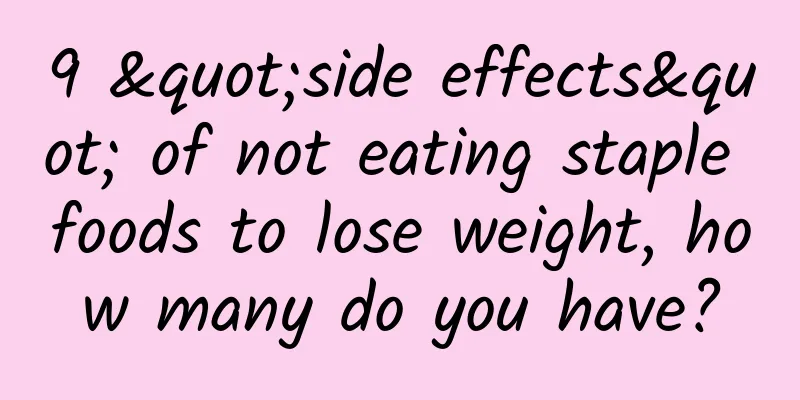9 "side effects" of not eating staple foods to lose weight, how many do you have?

|
Author: Xue Qingxin Have you ever stopped eating staple foods in order to lose weight? There are too many people who don't eat staple foods in order to lose weight. They do lose weight obviously in the early stage, but most of them are not as good as expected in the later stage. Not only may their weight rebound significantly due to resuming their diet, but they may also experience many discomfort symptoms due to excessive dieting. I don’t recommend you to use the method of not eating staple food to lose weight! As for the “side effects” of not eating staple food, this article will let you know. 1. The "side effects" of not eating staple foods - Bad breath: If the carbohydrate intake in the diet is too low, the body will start to use fat and protein for energy. Among them, incomplete fat metabolism will produce ketones[1], which have a smell similar to the smell of rotting and fermented fruit. This will cause this unpleasant odor in the mouth, sweat, and urine, especially when talking. At the same time, protein decomposition and metabolism will also produce ammonia, which is also an important cause of bad breath. -Hair loss: Eating too little staple food can easily lead to low total energy intake, which is equivalent to dieting to lose weight. It is easy to cause malnutrition, resulting in insufficient nutrition needed for hair growth. In addition, after converting to fat and protein for energy, the kidney excretion volume increases, and a large amount of vitamins and minerals necessary for hair growth will be excreted, which will cause hair loss. -Amenorrhea: Dieting to lose weight leads to insufficient intake of carbohydrates and calories. The body will sense the crisis and temporarily "turn off" the reproductive function for self-protection, turning on the "energy saving mode", which leads to amenorrhea in women. It is not easy to restore menstruation after amenorrhea. -Muscle loss: Staple foods are also important foods for providing protein. An adult woman needs 55 grams of protein per day. According to the recommendations in the "Dietary Guidelines for Chinese Residents", cereals should be eaten in an amount of 200 to 300 grams. Taking 200 grams of rice as an example, they can provide 15.8 grams of protein, which accounts for 28% of a woman's daily protein needs. - Fatigue: Staple foods mainly provide carbohydrates, which are the source of energy for the brain. The brain mainly relies on glucose in the blood for energy. If the intake is insufficient, symptoms of hypoglycemia will easily occur, and you will also feel tired and weak. - Increased risk of chronic diseases: Many people, while not eating staple foods, will significantly increase the proportion of meat in their diet, especially red meat, or even fatty and lean pork belly. Studies have shown that long-term excessive intake of red meat will increase the risk of obesity, type 2 diabetes, colorectal cancer and other diseases. [2] In addition, pork belly contains high saturated fatty acids, and excessive intake of saturated fatty acids will increase the risk of cardiovascular disease. - Impact on life expectancy: A cohort study of the American population showed that the percentage of energy provided by carbohydrates was U-shapedly correlated with all-cause mortality. When the percentage of energy provided by carbohydrates was 50%-55%, the mortality risk was the lowest, while carbohydrates <40% and carbohydrates >70% were associated with a higher mortality risk. [3] For women who are losing weight, if they eat 1500 kcal of food every day and get the recommended amount of fruits, vegetables, milk and beans, then 50% to 55% of carbohydrates is equivalent to 139 to 163 grams of cooked rice. - Irritability and depression: Long-term low-carb or ultra-low-carb diets that do not include staple foods may also cause mental symptoms such as depression and anger. [4] -Constipation: When you don’t eat staple foods during weight loss, your overall food intake is often low. As a result, there will be less food residue, which is not enough to make you want to defecate. This will cause the water in the small amount of food residue that reaches the large intestine first to be absorbed by the large intestine, and over time it will become dry and hard, which can easily lead to constipation. 2. How to eat staple foods to lose weight? If you want to control your weight or lose weight, you must first control your total calorie intake, because weight loss can only be more effective when energy intake is less than energy consumption. In order to control the total calorie intake, you must also control your appetite. During weight loss, you should pay attention to the order of eating. It is recommended to drink a bowl of light soup first → eat a mouthful of light vegetables → eat a mouthful of protein food (such as meat, eggs, soy products) → finally eat a mouthful of staple food. Just eat them in this order. At the same time, you should also pay attention to the combination of coarse and fine foods, and try to eat less refined white rice and flour, that is, refined carbohydrate foods. The combination of coarse and fine foods can increase the intake of dietary fiber and B vitamins, which can not only enhance satiety and control appetite, but also promote gastrointestinal motility, prevent constipation, and is beneficial for weight loss. 3. Be sure to eat less of these staple foods: Since we want to reduce the intake of refined white rice and flour, we should eat less white rice, white steamed buns, and white rice porridge. It is best not to eat various processed staple foods, such as biscuits, potato chips, French fries, egg rolls, cakes, sweet bread, fried dough sticks, fried cakes, rice cakes and other foods. These foods are not only high in calories, but also have a relatively high GI (glycemic index). For example, the GI of fried dough sticks is 75[5], which is higher than the GI of rice porridge and is considered a high GI food. The higher the GI of a food, the greater its impact on blood sugar, causing a rapid rise in blood sugar after a meal, which in turn stimulates increased insulin secretion in order to reduce the glucose content in the blood and convert it into liver glycogen, muscle glycogen or fat for storage. Therefore, eating high GI foods is not conducive to weight loss. 4. It is recommended to eat these staple foods: The most recommended foods to eat during weight loss are foods that are both filling and have a low GI. Whole grains and potato foods are the most suitable. For example, chickpeas, red beans, mung beans, oatmeal, buckwheat, barley rice, brown rice, black rice, sweet potatoes, purple sweet potatoes, potatoes, lotus roots and other foods. When making rice, you can replace 1/3 to 1/2 of the rice with whole grains or beans, or you can cut potatoes into pieces and add them to make whole grain and bean rice. 5. How much staple food is recommended? According to the recommendations in the Dietary Guidelines for Chinese Residents, cereals should be consumed at 200-300 grams per day, including 50-150 grams of whole grains and beans. It is also recommended to eat 50-100 grams of potato foods. A handful of rice weighs about 25 grams, or you can use a graduated measuring cup. A handful of chickpeas and a handful of mung beans weigh about 25 grams, and a fist of sweet potatoes weighs about 100 grams. Summarize: Although the process of losing weight is hard, don't make it hard on yourself. Not eating staple food for a long time or eating too little staple food will affect your health and is not conducive to weight loss. It may even be counterproductive and difficult to achieve the desired effect. Only by eating the right staple food can you lose weight healthily! References: [1]https://www.ncbi.nlm.nih.gov/books/NBK537084/ [2] Chinese Nutrition Society. Dietary Guidelines for Chinese Residents[M]. People's Medical Publishing House. 2022 [3]Seidelmann SB, Claggett B, Cheng S, Henglin M, Shah A, Steffen LM, Folsom AR, Rimm EB, Willett WC, Solomon SD. Dietary carbohydrate intake and mortality: a prospective cohort study and meta-analysis. Lancet Public Health. 2018 Sep;3(9):e419-e428. doi: 10.1016/S2468-2667(18)30135-X. Epub 2018 Aug 17. PMID: 30122560; PMCID: PMC6339822. [4] Chinese Nutrition Society. Blue Book on Obesity Prevention and Control in China[M]. Peking University Medical Press. 2019 [5] Yang Yuexin. Chinese Food Composition Table 6th Edition Volume 1[M]. Peking University Medical Press, 2018 |
<<: Simple and practical! 8 small actions to maintain a healthy kidney
>>: Asymco: Cracking the Chinese Code: Microsoft vs. Apple
Recommend
What are the normal reactions when using erosive suppositories?
Gynecological diseases have always been a problem...
32 weeks pregnant, hard and tight stomach
The 32nd week of pregnancy belongs to the middle ...
What causes breast pain and itchy nipples?
The so-called mastitis is a purulent infection of...
What are the common mistakes we make when dealing with infant convulsions?
After the winter solstice, the coldest days of th...
American Medical Association Recommendations: 2023 Health Guidelines
After experiencing the unpredictable 2022, everyo...
What to do if your period is drifting
If a woman is menstruating, swimming or strenuous...
How long can the placenta be kept frozen?
The placenta is a very important organ in the fem...
How long can I breastfeed after taking ceftriaxone during breastfeeding?
During breastfeeding, physical and mental health ...
This article is suitable for forwarding to the "loving family group"
This era does not only belong to young people. In...
34 weeks pregnant, no fetal movement for one day
After a period of time, the fetus will move back ...
The reason why girls get fatter the more they exercise
We all know that people need to exercise. Exercis...
How many weeks is the best time to do glucose tolerance test?
For women who are pregnant for the first time, so...
Is blended oil good? Should I buy it?
Recently, I ran out of oil at home, so I went to ...
Traditional Chinese Medicine Treatment of Breast Nodules
Breast problems in women are still very serious. ...









